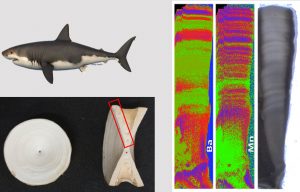John Mohan – University of New England
AFS Meeting Abstract: Sharks exhibit enigmatic movement patterns including long-distance migrations and deep diving behavior that can be difficult to characterize. Ontogenetic characteristics of many shark species, such as late maturity age, slow growth, increased longevities, and low reproductive output, make shark populations especially vulnerable to human exploitation. Conservation and management efforts rely on understanding the complex life histories of highly migratory sharks, including movements, age, growth and feeding patterns. The mineralized vertebral cartilage in sharks is useful for estimating age, as growth bands are deposited over time and encompass the complete life history, including in utero development. This study reconstructs the environmental histories and feeding patterns of migratory white sharks (Carcharodon carcharias) by utilizing natural chemical biomarker (trace elements and stable isotopes) proxies contained in vertebral cartilage growth bands. Vertebrae samples of white sharks were collected opportunistically from coastal Mexican artisanal fisheries in the Pacific (N=12 juveniles) and the Gulf of California (N=3 subadults). Vertebrae were sectioned to expose the growth bands and elemental profiles were quantified from the vertebral focus to the edge using laser ablation ICP MS, encompassing the complete life history. Elemental patterns will be compared between capture locations and between juveniles and subadults to investigate ontogenetic shifts in habitat use. Chemical records contained in vertebral cartilage holds promise to advance our understanding of migratory shark life histories.
Download Powerpoint presentation here
© 2025 Jackson School of Geosciences, The University of Texas at Austin



